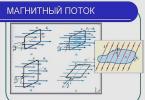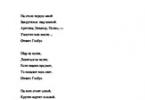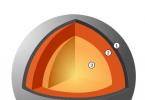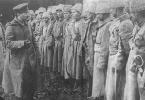DEFINITION
Carbon dioxide(carbon dioxide, carbonic anhydride, carbon dioxide) – carbon monoxide (IV).
Formula – CO 2. Molar mass – 44 g/mol.
Chemical properties of carbon dioxide
Carbon dioxide belongs to the class of acidic oxides, i.e. When interacting with water, it forms an acid called carbonic acid. Carbonic acid is chemically unstable and at the moment of formation it immediately breaks down into its components, i.e. The reaction between carbon dioxide and water is reversible:
CO 2 + H 2 O ↔ CO 2 ×H 2 O(solution) ↔ H 2 CO 3 .
When heated, carbon dioxide breaks down into carbon monoxide and oxygen:
2CO 2 = 2CO + O 2.
Like all acidic oxides, carbon dioxide is characterized by reactions of interaction with basic oxides (formed only by active metals) and bases:
CaO + CO 2 = CaCO 3;
Al 2 O 3 + 3CO 2 = Al 2 (CO 3) 3;
CO 2 + NaOH (dilute) = NaHCO 3 ;
CO 2 + 2NaOH (conc) = Na 2 CO 3 + H 2 O.
Carbon dioxide does not support combustion; only active metals burn in it:
CO 2 + 2Mg = C + 2MgO (t);
CO 2 + 2Ca = C + 2CaO (t).
Carbon dioxide reacts with simple substances such as hydrogen and carbon:
CO 2 + 4H 2 = CH 4 + 2H 2 O (t, kat = Cu 2 O);
CO 2 + C = 2CO (t).
When carbon dioxide reacts with peroxides of active metals, carbonates are formed and oxygen is released:
2CO 2 + 2Na 2 O 2 = 2Na 2 CO 3 + O 2.
A qualitative reaction to carbon dioxide is the reaction of its interaction with lime water (milk), i.e. with calcium hydroxide, in which a white precipitate is formed - calcium carbonate:
CO 2 + Ca(OH) 2 = CaCO 3 ↓ + H 2 O.
Physical properties of carbon dioxide
Carbon dioxide is a gaseous substance without color or odor. Heavier than air. Thermally stable. When compressed and cooled, it easily transforms into liquid and solid states. Carbon dioxide in a solid aggregate state is called “dry ice” and easily sublimes at room temperature. Carbon dioxide is poorly soluble in water and partially reacts with it. Density – 1.977 g/l.
Production and use of carbon dioxide
There are industrial and laboratory methods for producing carbon dioxide. Thus, in industry it is obtained by burning limestone (1), and in the laboratory by the action of strong acids on carbonic acid salts (2):
CaCO 3 = CaO + CO 2 (t) (1);
CaCO 3 + 2HCl = CaCl 2 + CO 2 + H 2 O (2).
Carbon dioxide is used in the food (carbonating lemonade), chemical (temperature control in the production of synthetic fibers), metallurgical (environmental protection, such as brown gas precipitation) and other industries.
Examples of problem solving
EXAMPLE 1
| Exercise | What volume of carbon dioxide will be released by the action of 200 g of a 10% solution of nitric acid per 90 g of calcium carbonate containing 8% impurities insoluble in acid? |
| Solution | Molar masses of nitric acid and calcium carbonate, calculated using the table of chemical elements by D.I. Mendeleev - 63 and 100 g/mol, respectively. Let us write the equation for the dissolution of limestone in nitric acid: CaCO 3 + 2HNO 3 → Ca(NO 3) 2 + CO 2 + H 2 O. ω(CaCO 3) cl = 100% - ω admixture = 100% - 8% = 92% = 0.92. Then, the mass of pure calcium carbonate is: m(CaCO 3) cl = m limestone × ω(CaCO 3) cl / 100%; m(CaCO 3) cl = 90 × 92 / 100% = 82.8 g. The amount of calcium carbonate substance is equal to: n(CaCO 3) = m(CaCO 3) cl / M(CaCO 3); n(CaCO 3) = 82.8 / 100 = 0.83 mol. The mass of nitric acid in solution will be equal to: m(HNO 3) = m(HNO 3) solution × ω(HNO 3) / 100%; m(HNO 3) = 200 × 10 / 100% = 20 g. The amount of calcium nitric acid is equal to: n(HNO 3) = m(HNO 3) / M(HNO 3); n(HNO 3) = 20 / 63 = 0.32 mol. By comparing the amounts of substances that reacted, we determine that nitric acid is in short supply, therefore, further calculations are made using nitric acid. According to the reaction equation n(HNO 3): n(CO 2) = 2:1, therefore n(CO 2) = 1/2×n(HNO 3) = 0.16 mol. Then, the volume of carbon dioxide will be equal to: V(CO 2) = n(CO 2)×V m; V(CO 2) = 0.16 × 22.4 = 3.58 g. |
| Answer | The volume of carbon dioxide is 3.58 g. |
The most common processes for the formation of this compound are the rotting of animal and plant remains, the combustion of various types of fuel, and the respiration of animals and plants. For example, one person emits about a kilogram of carbon dioxide into the atmosphere per day. Carbon monoxide and dioxide can also be formed in inanimate nature. Carbon dioxide is released during volcanic activity and can also be produced from mineral water sources. Carbon dioxide is found in small quantities in the Earth's atmosphere.
The peculiarities of the chemical structure of this compound allow it to participate in many chemical reactions, the basis for which is carbon dioxide.
Formula
In the compound of this substance, the tetravalent carbon atom forms a linear bond with two oxygen molecules. The appearance of such a molecule can be represented as follows:

The hybridization theory explains the structure of the carbon dioxide molecule as follows: the two existing sigma bonds are formed between the sp orbitals of carbon atoms and the two 2p orbitals of oxygen; The p-orbitals of carbon, which do not take part in hybridization, are bonded in conjunction with similar orbitals of oxygen. In chemical reactions, carbon dioxide is written as: CO 2.
Physical properties
Under normal conditions, carbon dioxide is a colorless, odorless gas. It is heavier than air, which is why carbon dioxide can behave like a liquid. For example, it can be poured from one container to another. This substance is slightly soluble in water - about 0.88 liters of CO 2 dissolve in one liter of water at 20 ⁰C. A slight decrease in temperature radically changes the situation - 1.7 liters of CO 2 can dissolve in the same liter of water at 17⁰C. With strong cooling, this substance precipitates in the form of snow flakes - the so-called “dry ice” is formed. This name comes from the fact that at normal pressure the substance, bypassing the liquid phase, immediately turns into a gas. Liquid carbon dioxide is formed at a pressure just above 0.6 MPa and at room temperature.

Chemical properties
When interacting with strong oxidizing agents, 4-carbon dioxide exhibits oxidizing properties. The typical reaction of this interaction is:
C + CO 2 = 2CO.
Thus, with the help of coal, carbon dioxide is reduced to its divalent modification - carbon monoxide.
Under normal conditions, carbon dioxide is inert. But some active metals can burn in it, removing oxygen from the compound and releasing carbon gas. A typical reaction is the combustion of magnesium:
2Mg + CO 2 = 2MgO + C.
During the reaction, magnesium oxide and free carbon are formed.

In chemical compounds, CO 2 often exhibits the properties of a typical acid oxide. For example, it reacts with bases and basic oxides. The result of the reaction is carbonic acid salts.
For example, the reaction of a compound of sodium oxide with carbon dioxide can be represented as follows:
Na 2 O + CO 2 = Na 2 CO 3;
2NaOH + CO 2 = Na 2 CO 3 + H 2 O;
NaOH + CO 2 = NaHCO 3.
Carbonic acid and CO 2 solution
Carbon dioxide in water forms a solution with a small degree of dissociation. This solution of carbon dioxide is called carbonic acid. It is colorless, weakly expressed and has a sour taste.
Recording a chemical reaction:
CO 2 + H 2 O ↔ H 2 CO 3.
The equilibrium is shifted quite strongly to the left - only about 1% of the initial carbon dioxide is converted into carbonic acid. The higher the temperature, the fewer carbonic acid molecules in the solution. When the compound boils, it disappears completely, and the solution disintegrates into carbon dioxide and water. The structural formula of carbonic acid is presented below.

Properties of carbonic acid
Carbonic acid is very weak. In solutions, it breaks down into hydrogen ions H + and compounds HCO 3 -. CO 3 - ions are formed in very small quantities.
Carbonic acid is dibasic, so the salts formed by it can be medium and acidic. In the Russian chemical tradition, medium salts are called carbonates, and strong salts are called bicarbonates.
Qualitative reaction
One possible way to detect carbon dioxide gas is to change the clarity of the lime mortar.
Ca(OH) 2 + CO 2 = CaCO 3 ↓ + H 2 O.
This experience is known from a school chemistry course. At the beginning of the reaction, a small amount of white precipitate is formed, which subsequently disappears when carbon dioxide is passed through water. The change in transparency occurs because during the interaction process, an insoluble compound - calcium carbonate - is converted into a soluble substance - calcium bicarbonate. The reaction proceeds along this path:
CaCO 3 + H 2 O + CO 2 = Ca(HCO 3) 2.
Production of carbon dioxide
If you need to get a small amount of CO2, you can start the reaction of hydrochloric acid with calcium carbonate (marble). The chemical notation for this interaction looks like this:
CaCO 3 + HCl = CaCl 2 + H 2 O + CO 2.
Also for this purpose, combustion reactions of carbon-containing substances, for example acetylene, are used:
CH 4 + 2O 2 → 2H 2 O + CO 2 -.
A Kipp apparatus is used to collect and store the resulting gaseous substance.
For the needs of industry and agriculture, the scale of carbon dioxide production must be large. A popular method for this large-scale reaction is to burn limestone, which produces carbon dioxide. The reaction formula is given below:
CaCO 3 = CaO + CO 2.
Applications of carbon dioxide
The food industry, after large-scale production of “dry ice,” switched to a fundamentally new method of storing food. It is indispensable in the production of carbonated drinks and mineral water. The CO 2 content in drinks gives them freshness and significantly increases their shelf life. And carbidization of mineral waters allows you to avoid mustiness and unpleasant taste.

In cooking, the method of extinguishing citric acid with vinegar is often used. The carbon dioxide released during this process imparts fluffiness and lightness to confectionery products.
This compound is often used as a food additive to increase the shelf life of food products. According to international standards for the classification of chemical additives contained in products, it is coded E 290,
Powdered carbon dioxide is one of the most popular substances included in fire extinguishing mixtures. This substance is also found in fire extinguisher foam.
It is best to transport and store carbon dioxide in metal cylinders. At temperatures above 31⁰C, the pressure in the cylinder can reach critical and liquid CO 2 will go into a supercritical state with a sharp rise in operating pressure to 7.35 MPa. The metal cylinder can withstand internal pressure up to 22 MPa, so the pressure range at temperatures above thirty degrees is considered safe.
Let's imagine this situation:
You are working in a laboratory and have decided to conduct an experiment. To do this, you opened the cabinet with reagents and suddenly saw the following picture on one of the shelves. Two jars of reagents had their labels peeled off and safely remained lying nearby. At the same time, it is no longer possible to determine exactly which jar corresponds to which label, and the external signs of the substances by which they could be distinguished are the same.
In this case, the problem can be solved using the so-called qualitative reactions.
Qualitative reactions These are reactions that make it possible to distinguish one substance from another, as well as to find out the qualitative composition of unknown substances.
For example, it is known that cations of some metals, when their salts are added to the burner flame, color it a certain color:
This method can only work if the substances being distinguished change the color of the flame differently, or one of them does not change color at all.
But, let’s say, as luck would have it, the substances being determined do not color the flame, or color it the same color.
In these cases, it will be necessary to distinguish substances using other reagents.
In what case can we distinguish one substance from another using any reagent?
There are two options:
- One substance reacts with the added reagent, but the second does not. In this case, it must be clearly visible that the reaction of one of the starting substances with the added reagent actually took place, that is, some external sign of it is observed - a precipitate formed, a gas was released, a color change occurred, etc.
For example, it is impossible to distinguish water from a solution of sodium hydroxide using hydrochloric acid, despite the fact that alkalis react well with acids:
NaOH + HCl = NaCl + H2O
This is due to the absence of any external signs of a reaction. A clear, colorless solution of hydrochloric acid when mixed with a colorless hydroxide solution forms the same clear solution:
But on the other hand, you can distinguish water from an aqueous solution of alkali, for example, using a solution of magnesium chloride - in this reaction a white precipitate forms:
2NaOH + MgCl 2 = Mg(OH) 2 ↓+ 2NaCl
2) substances can also be distinguished from each other if they both react with the added reagent, but do so in different ways.
For example, you can distinguish a sodium carbonate solution from a silver nitrate solution using a hydrochloric acid solution.
Hydrochloric acid reacts with sodium carbonate to release a colorless, odorless gas - carbon dioxide (CO 2):
2HCl + Na 2 CO 3 = 2NaCl + H 2 O + CO 2
and with silver nitrate to form a white cheesy precipitate AgCl
HCl + AgNO 3 = HNO 3 + AgCl↓
The tables below present various options for detecting specific ions:
Qualitative reactions to cations
| Cation | Reagent | Sign of reaction |
| Ba 2+ | SO 4 2- |
Ba 2+ + SO 4 2- = BaSO 4 ↓ |
| Cu 2+ | 1) Precipitation of blue color: Cu 2+ + 2OH − = Cu(OH) 2 ↓ 2) Black precipitate: Cu 2+ + S 2- = CuS↓ |
|
| Pb 2+ | S 2- | Black precipitate: Pb 2+ + S 2- = PbS↓ |
| Ag+ | Cl − |
Precipitation of a white precipitate, insoluble in HNO 3, but soluble in ammonia NH 3 ·H 2 O: Ag + + Cl − → AgCl↓ |
| Fe 2+ |
2) Potassium hexacyanoferrate (III) (red blood salt) K 3 |
1) Precipitation of a white precipitate that turns green in air: Fe 2+ + 2OH − = Fe(OH) 2 ↓ 2) Precipitation of a blue precipitate (Turnboole blue): K + + Fe 2+ + 3- = KFe↓ |
| Fe 3+ |
2) Potassium hexacyanoferrate (II) (yellow blood salt) K 4 3) Rodanide ion SCN − |
1) Brown precipitate: Fe 3+ + 3OH − = Fe(OH) 3 ↓ 2) Precipitation of blue precipitate (Prussian blue): K + + Fe 3+ + 4- = KFe↓ 3) The appearance of intense red (blood red) coloring: Fe 3+ + 3SCN − = Fe(SCN) 3 |
| Al 3+ | Alkali (amphoteric properties of hydroxide) |
Precipitation of a white precipitate of aluminum hydroxide when adding a small amount of alkali: OH − + Al 3+ = Al(OH) 3 and its dissolution upon further pouring: Al(OH) 3 + NaOH = Na |
| NH4+ | OH − , heating | Emission of gas with a pungent odor: NH 4 + + OH − = NH 3 + H 2 O Blue turning of wet litmus paper |
| H+ (acidic environment) |
Indicators: − litmus − methyl orange |
Red staining |




